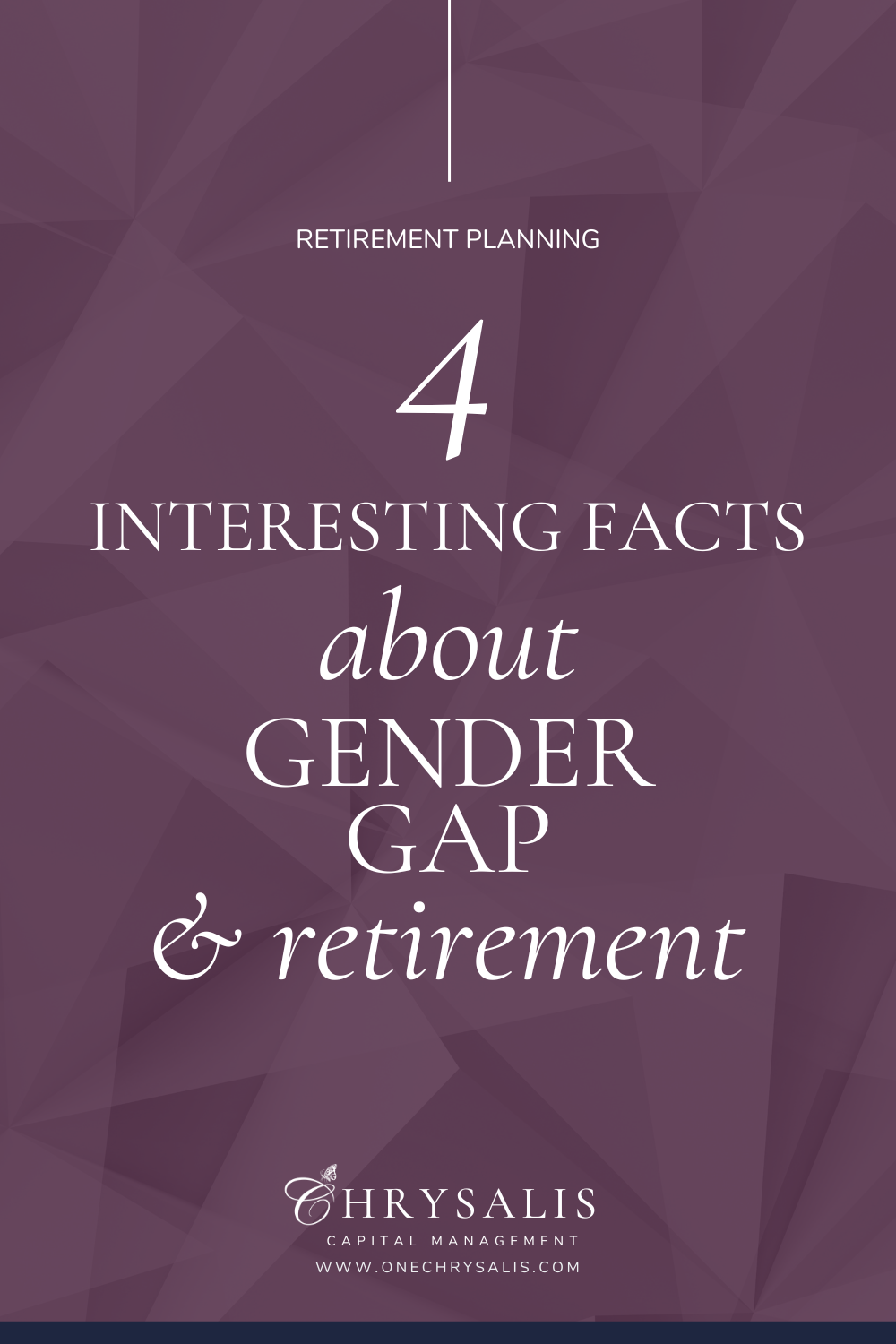
RETIREMENT PLANNING
4 Facts About the Gender Gap in Retirement
Quick Synopsis:
Discover four critical facts about the gender gap in retirement and learn strategies to bridge the divide. Explore issues like savings discrepancy, life expectancy, wage disparity, and retirement confidence gap. Get tips on customized savings strategies, investment education, holistic financial planning, and optimizing employer plans to secure your financial future.
4 Facts About the Gender Gap and Retirement
Retirement planning is a crucial aspect of financial stability and security in one’s later years. However, the journey to a comfortable retirement is often more challenging for women due to a persistent gender gap. This gender gap in retirement can significantly impact their savings, retirement confidence, and overall financial well-being.
In this blog post, we’ll explore four critical facts about the gender gap in retirement and discuss strategies to bridge this divide.
1. Savings Discrepancy
The discrepancy in retirement savings between men and women is a significant issue. Various factors contribute to this gap, including differences in career paths, income levels, and time spent in the workforce.
Causes of the Savings Discrepancy
- Career Interruptions: Women are more likely to take career breaks to care for children or elderly family members. These interruptions can result in lower lifetime earnings and reduced retirement savings.
- Part-Time Work: Women are more likely than men to work part-time, which often comes with fewer benefits and lower pay.
- Lower Wages: Women generally earn less than men, which directly impacts their ability to save for retirement.
Addressing the Discrepancy
- Customized Savings Strategies: Women should consider maximizing contributions to retirement accounts during their working years. Utilizing employer-sponsored retirement plans, IRAs, and catch-up contributions can help mitigate the impact of career interruptions.
- Investment Education & Advisory: Gaining a better understanding of investment options and seeking professional financial advice can empower women to make informed decisions that enhance their retirement savings.
2. Life Expectancy
Women typically live longer than men, which means their retirement savings need to last longer. This increased longevity requires careful planning to ensure financial security throughout retirement.
Challenges of Longer Life Expectancy
- Increased Healthcare Costs: Longer life spans often result in higher healthcare expenses, including long-term care.
- Extended Retirement Period: Women need to stretch their savings over a more extended period, which can be challenging if their savings are already lower than men’s.
Strategies for Longevity
- Holistic Financial Planning: Incorporating long-term healthcare costs into retirement planning is essential. Women should consider purchasing long-term care insurance and creating a comprehensive financial plan that accounts for their extended life expectancy.
- Employer Plan Optimization: Women should take full advantage of employer-provided retirement benefits, including matching contributions, to build a robust retirement fund that can support a longer retirement.
3. Wage Disparity
Wage disparity between men and women is a well-documented issue that has significant implications for retirement savings. On average, women earn less than men, which directly affects their ability to save and invest for retirement.
Impact of Wage Disparity
- Lower Savings Contributions: Lower wages mean women have less disposable income to allocate toward retirement savings.
- Reduced Investment Growth: Smaller contributions result in less capital available for investment, leading to lower overall growth of retirement funds.
Bridging the Wage Gap
- Negotiation and Advocacy: Women should be encouraged to negotiate for higher salaries and advocate for equal pay. Transparent salary practices and organizational support for pay equity can also help close the wage gap.
- Customized Savings Strategies: Even with lower wages, women can implement effective savings strategies. Automating savings, taking advantage of employer matches, and prioritizing retirement contributions can make a significant difference over time.
4. Retirement Confidence Gap
The retirement confidence gap refers to the difference in how confident men and women feel about their retirement prospects. Studies show that women are generally less confident than men in their ability to retire comfortably.
Factors Contributing to the Confidence Gap
- Financial Literacy: Lower levels of financial literacy among women can contribute to a lack of confidence in retirement planning.
- Risk Aversion: Women tend to be more risk-averse than men, which can lead to more conservative investment strategies and potentially lower returns.
Building Retirement Confidence
- Investment Education & Advisory: Improving financial literacy through education and professional advice can boost women’s confidence in their retirement planning. Financial advisors can help women understand their investment options and develop strategies that align with their risk tolerance.
- Holistic Financial Planning: A comprehensive approach to financial planning that includes budgeting, saving, investing, and risk management can provide women with a clearer path to retirement security.
Customized Savings Strategies
Given the unique challenges women face, customized savings strategies are essential for closing the retirement gap. Tailored advice and personalized plans can help women maximize their savings potential.
Key Strategies
- Maximize Employer Contributions: Women should take full advantage of employer-sponsored retirement plans, especially those that offer matching contributions.
- Catch-Up Contributions: For women over 50, catch-up contributions to retirement accounts can significantly boost savings.
- Diversified Investments: A diversified investment portfolio that balances risk and return can help grow retirement savings more effectively.
Investment Education & Advisory
Education and professional advice are crucial for empowering women to make informed financial decisions. Understanding investment principles and options can lead to better retirement outcomes.
Educational Initiatives
- Workshops and Seminars: Employers and financial institutions can offer workshops and seminars focused on retirement planning and investment education for women.
- One-on-One Advising: Personalized financial advising can provide women with tailored strategies to meet their retirement goals.
Holistic Financial Planning
A holistic approach to financial planning considers all aspects of a woman’s financial life, from budgeting and saving to investing and risk management. This comprehensive approach ensures that all financial needs are addressed.
Comprehensive Planning
- Budgeting: Creating and maintaining a budget is fundamental to managing finances and freeing up resources for retirement savings.
- Insurance: Incorporating health, life, and long-term care insurance into the financial plan can protect against unforeseen expenses and ensure financial stability.
Employer Plan Optimization
Employers play a crucial role in helping women optimize their retirement savings. By offering robust retirement plans and educating employees about these benefits, employers can support women in building a secure financial future.
Employer Actions
- Education and Communication: Employers should provide clear information about retirement plan options and benefits.
- Incentives: Offering incentives such as matching contributions can encourage women to contribute more to their retirement plans.
Conclusion
The gender gap in retirement is a multifaceted issue that requires targeted strategies to address. By understanding the challenges of savings discrepancy, life expectancy, wage disparity, and the retirement confidence gap, women can take proactive steps to secure their financial futures. Customized savings strategies, investment education, holistic financial planning, and optimizing employer plans are essential components of a comprehensive approach to closing the gender gap in retirement.
Ready to Bridge the Gender Gap and Take Control of Your Retirement Planning?
Our financial advisory services are tailored to help you maximize your savings, invest wisely, and plan holistically for a secure and vibrant future. Schedule a free consultation with our expert advisors today and start building the retirement you deserve!
About Us
At Chrysalis Capital Management, we’re committed to helping you embrace the abundance mindset as a cornerstone of your financial success. Through personalized coaching and resources, we guide you in aligning your mindset with your financial goals, helping you make empowered decisions that pave the way for a prosperous and fulfilling future.


I’m Stephanie
I empower women to achieve true financial freedom through expert wealth guidance and personalized coaching.
I’m not your typical financial advisor, I’m committed to redefining the way you approach wealth management. No more jargon filled, stuffy financial tasks – I’m all about making finances as exciting as that perfect getaway vacation.
Welcome!

Are You Financially Fit?
Test your financial fitness level with this 3 minute quiz!
TOP CATEGORIES

Financial Planning
Explore essential topics like budgeting, goal setting, and debt management to achieve financial security and peace of mind.

Investment Strategies
Dive into the world of investments, from understanding different asset classes to crefting effective investment strategies for wealth growth.

Retirement Planning
Discover insights and tips to ensure a comfortable and worry-free retirement, covering retirement income, savings plans, and financial security.
